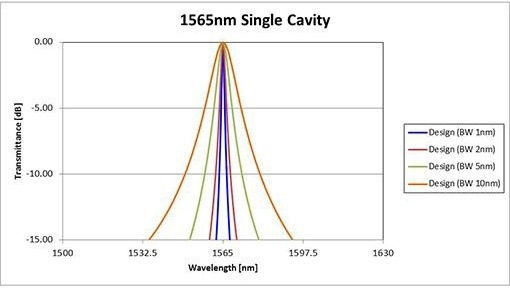Etalons are a type of Fabry–Pérot interferometer – an optical cavity made from two parallel reflecting surfaces. They can act as optical filters since only the frequencies matched to the resonant frequencies of the cavity can pass through the cavity. As a result, they are often used as ultra-narrow bandpass filters.
How Etalon Filters Work
Achieving the characteristic transmission function of an etalon relies on the optical interference inside the cavity resulting from interference occurring during the multiple passes of the light between the two mirrors. Constructive interference can only occur if the two waves are in-phase, which is a function of the optical path length differences between them and this path length is related to the size of the cavity.
Etalon filters are available in a variety of materials depending on which spectral range they need to operate in and the intended applications. The cavity sizes can also vary significantly in their dimensions, as can the resultant optical performance.
How Etalons are Used in Datacoms
Data communications (datacoms) represent one of the key applications of etalon filters. They are used to isolate narrow wavelength bands for data transmission over large distances – typically through optical fibers.
Etalons can make ideal wavelength lockers for datacoms as they are compact, are passive components and tend to be robust and reliable. It is also possible to create etalons that operate at multiple wavelengths, allowing a single device to cover a broad range of wavelengths. Etalons also have the unique ability to be used to monitor optical power and transmitted wavelengths, so can serve multiple purposes in datacoms.
Choosing an Etalon Filter
When choosing an etalon filter there are a number of factors to consider. One is the operating wavelengths for the filter to transmit, as this will determine which materials are suitable. Another two factors are the finesse and the free spectral range.
The finesse of an etalon determines the peak shape of the transmitted light. Low finesse etalons give rise to broad fringes unsuitable for applications requiring truly ultra-narrowband filters. The free spectral range is the spacing between each of the subsequent transmitted peaks.
Many incident laser sources have their own instabilities and noise, and the stable characteristics of the etalon cavity can be utilized to maintain the wavelength lock despite any drifts in the light source.
Etalon Filters from Iridian Spectral Technologies
High finesse etalon filters are particularly valuable in datacoms as they can be used as very precise wavelength references. The higher the finesse, the narrower the bandwidth of the transmitted light and the more precisely the central wavelength of the transmitted light can be determined.
Wavelength referencing with the large number of spectral fringes that can be generated from an etalon can be used for very accurate wavelength determinations. Wavelength-division multiplexing often requires the use of very closely spaced wavelengths for data transfer which also need to be characterized to avoid issues such as cross-talk between channels. This means the demand on the wavelength precision is very high.
Iridian Spectral Technologies is an expert in the manufacturing of high-performance optical filters, including etalon filters for datacoms. Developing optics that meet the technical demands required by the datacoms industry means maintaining extremely high precision and accuracy in the manufacturing processes. Minor defects in the shape or surface smoothness of the parallel optical flat surfaces in the etalon can lead to reduced performance.
Iridian Spectral Technologies makes use of the highest quality polishing technologies to provide the solid etalons that are commonly used in datacoms, using custom designs to meet specific customer requirements.

